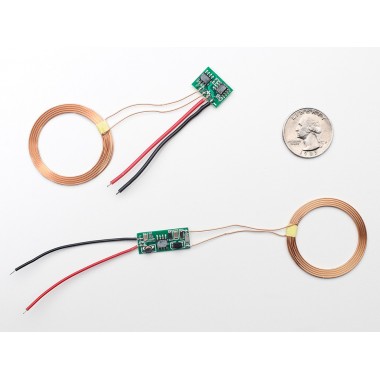Productos
Inductive Charging Set - 5V @ 500mA max

Módulo de carga inductiva de hasta 500mA. Ideal como cargador de dispositivos o alimentación inalámbrica.
COD: D001407
Peso: 0.015 Kg
Disponibilidad: En Stock
ARS 6990.00
El producto no está disponible para la venta en este momento
Características
Description
Inductive charging is a way of powering a device without a direct wire connection. Most people have seen inductive charging in a rechargable electric toothbrush: you may have noticed that you recharge it by placing it into the holder, but there's no direct plug. These chargers work by taking a power transformer and splitting it in half, an AC waveform is generated into one, and couples into the second coil.
This is a basic charger set, and it does work, providing 5V DC output from the output half when the input half is powered with 9V to 12VDC. You can draw as much as ~500mA if the coils are 2 or 3 mm apart. If you only need 100 or 200mA you can be up 7mm apart. For 10mA draw, the coils can be up to half an inch (12.5mm) apart. Any non-ferrous/non-conductive material (eg air, wood, leather, plastic, paper, glass) can be used between the two coils. The material doesn't affect the distance or efficiency. The coils do need to be fairly co-axial, try to get them to be parallel and have the circles line up for best power-transfer. (This is why the electric toothbrush must fit into the plastic holder, it's lining up the two coils for best efficiency)
Because its an air-core transformer, it's fairly inefficient. Only about 40% of the energy in shows up on the other end, but for low power or charging project. If you draw 5V 100mA on the output side (0.5W), you'll need 0.5W * 2.5 / 9V = ~150mA from the input end. The quiescent current is about 70mA at all time, even when the other coil is not anywhere near by.
Technical Details
- Coils are 1.5"/38mm diameter
- Receiver weight: 5.5g
- Transmitter weight 5.7g
Archivos
Comentarios
Escribir ComentarioOpenHacks (16/07/2015 - 10:11)
Hola Pablo, es posible pero no es muy simple. Tenes que cambiar la resistencia del divisor de tensión de realimentación -en la placa de salida- a un valor que te permita leer los 3.7V. Saludos!




